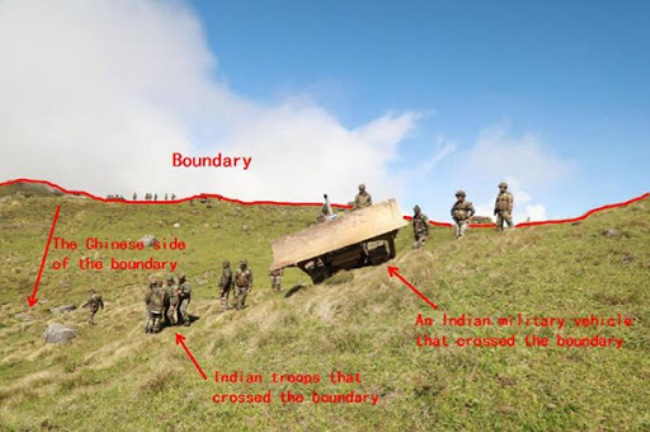INDIA-CHINA CLASH IN BORDER 20 INDIAN KILLED IN LADAKH FIGHTING

Odishabarta,Bureau
NEW DELHI: Twenty Indian soldiers have been killed in clashes with Chinese troops high in the Himalayas, the Indian army said on Tuesday. This marks the most serious conflict between the two nuclear-armed neighbors in decades. The deaths took place in the mountainous region of Ladakh where India and China share a disputed but largely peaceful border.
Colonel B Santosh Babu of the Bihar regiment, Havildar Palani and Sepoy Ojha laid down their lives for India, the army confirmed earlier today. “17 Indian troops who were critically injured in the line of duty at the stand-off location and exposed to sub-zero temperatures in the high altitude terrain have succumbed to their injuries. Indian Army is firmly committed to protect the territorial integrity and sovereignty of the nation,” the army’s fresh statement said tonight.
News agency ANI claimed that sources had confirmed 43 Chinese soldiers have been killed or seriously injured because of intercepts, though the army’s statement did not refer to this. A statement in the morning that confirmed the death of a Colonel and two jawans spoke of “casualties on both sides”.
Prime Minister Narendra Modi also held meetings with Home Minister Amit Shah and Defence Minister Rajnath Singh and met with military chiefs twice to discuss a response to the escalation.
For more than six weeks, soldiers from both sides have been engaged in a stand-off on at least two locations along the Line of Actual Control — the 3,488 km de-facto boundary between India and China, and rushed additional troops to the border. They have been facing each other at the Galwan River, which was one of the early triggers of the 1962 India-China war, and at the Pangong Tso — a glacial lake at 14,000 feet in the Tibetan plateau.
As per reports, no Indian soldiers have been killed in clashes on the frontier between the two countries since 1975 and no casualties of this magnitude have occurred since 1967.
The world’s two most populous nations, India and China are both rising powers that view each other warily. Apart from a war in 1962, they have tended to resolve periodic flare-ups along the border through negotiation.
In recent weeks, however, tensions between the two countries have spiked. Indian and Chinese troops engaged in physical brawls that left dozens injured at two points along their 2,200-mile frontier.
Chinese troops have also moved to establish a presence in four areas claimed by India near the unofficial border in Ladakh, leading to a tense standoff involving thousands of troops from both countries. Senior military officials have held meetings in the area to try to resolve the issue.
Instead, the clash on Monday night marks a grave escalation. India at first said that three soldiers had died in a “violent faceoff” that caused “casualties on both sides.” Later Tuesday, the Indian Army said in a statement that 17 more Indian troops who were “critically injured in the line of duty” had “succumbed to their injuries.” It did not say how they were killed. The troops of the two armies in the area subsequently “disengaged,” the statement said.
Col. Zhang Shuli, a spokesman for the Chinese military, said there had been a “fierce physical conflict, causing casualties.” He accused India of crossing the unofficial border between the two countries known as the “Line of Actual Control” to “launch a provocative attack.” India blamed the conflict on China’s attempt to “change the status quo” in the area.
The clash comes at a time when China is flexing its muscles across the region amid a global pandemic. In recent weeks it has confronted Malaysian and Vietnamese vessels in the South China Sea and twice sailed an aircraft carrier through the Taiwan Strait. China also unilaterally moved to seize new powers over Hong Kong.
Last month, President Trump said that the United States was “ready, willing and able to mediate or arbitrate” what he described as a “raging border dispute” between India and China. Neither country accepted the offer.
It is unclear exactly what prompted Monday’s conflict or how the injuries were caused. One of the Indian soldiers who was killed was a father of two serving in an artillery regiment, according to his family.
Hu Xijin, editor of the nationalist state-run newspaper, the Global Times, said on Chinese-language Weibo that his sources told him there had been Chinese casualties in the clash, but he did not specify if there were any deaths or give further details.
“I want to tell Indians: do not misjudge China’s restraint as weakness, and never be arrogant before China,” he said. “China does not want conflict with India, but it is never afraid of conflict.”
Song Zhongping, a Chinese military analyst and former lecturer at the People’s Liberation Army Rocket Force University of Engineering, accused India of engaging in a series of premeditated escalations “to distract from their domestic political situation.” China needs to “try the best methods to resolve the issue by diplomatic means, but also prepare militarily for the worst outcome.”
Earlier this month the Chinese military staged a drill that moved thousands of paratroopers “within hours” from central Hubei province to a remote Himalayan mountain range. The exercise, which was publicized by the PLA, was designed to send a message that China was able to rapidly deploy reinforcements to the Indian border and fight in low-temperature and low-oxygen conditions, according to state media.
Indian analysts said that China’s actions were another sign of its aggressive intentions in the region. There is a “new edge” to China’s attitude, said Nirupama Rao, a former Indian ambassador to China. “This assertiveness, this readiness to throw away internationally accepted behavior to advance their claims and interests; it’s worrisome for so many countries.”
Source;pns, Photo;en.com






